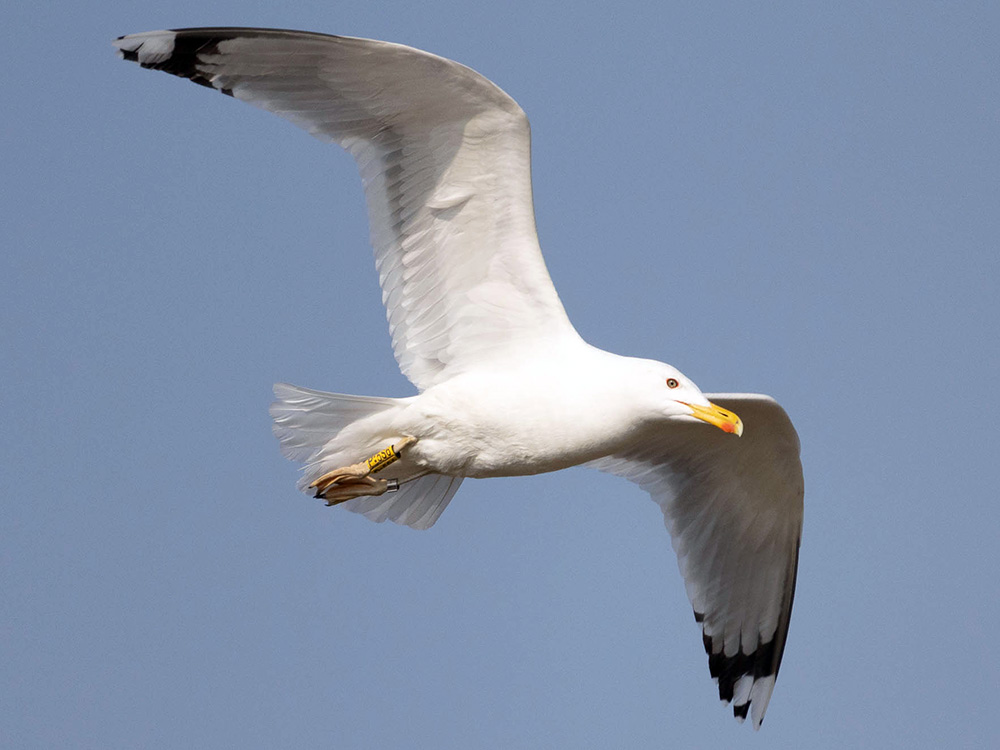Articel Content
Tracing the ancestry of the large gull.
Text: Yvonne Vahlensieck
Within a relatively short time span, large gulls (genus Larus) have split into numerous new species and conquered the Northern Hemisphere. Researchers are now looking for the secret behind this rapid adaptability in their DNA.
“Whether or not you like gulls is all a matter of perspective,” says evolutionary biologist David Alexander Marques. For some, they’re flying menaces, flocks of squawking bandits ready to snap the fench fries right out of your hand. For others, the sight of a European herring gull with outstretched wings gliding over the heads of vacationers is as quintessential to any seaside holiday as sand between your toes.
Yet it’s a little-known fact that large white-headed gulls of the genus Larus, which includes the European herring gull, constitute an evolutionary mystery: These birds generate new species at an astonishing rate. “It takes an average of one to two million years for a new species of bird to emerge. But this lineage has produced 16 species and 35 subspecies in less than one million years,” reports Marques. Marques, a passionate ornithologist and curator of vertebrates at the Natural History Museum Basel, aims to identify the mechanisms underlying the phenomenon. To do this, he is working together with the University of Basel to reconstruct the evolutionary history of these gulls.
“The past is key to learning how species adapt rapidly to new living conditions,” says Marques. Species diversity is on the decline due to climate change, habitat loss and the spread of non-native species. Insights from this study could improve how we manage the biodiversity crisis, for example, by allowing researchers to predict which species may encounter problems.
Marques’s project is only possible thanks to advances in DNA sequencing and the analysis of large datasets: After all, his team must start by decoding the 1.4 billion “letters” comprising the genome of all Larus species. Then genetic sequences will be compared using sophisticated computer programs.
Collecting samples from around the world.
“The first step was to collect DNA samples from at least three individuals belonging to each species and subspecies,” says Marques. To do this, his team collaborated with gull enthusiasts – both researchers and volunteer groups – from all over the world. In Poland, Marques helped a local team band European herring gulls and Caspian gulls so that he could collect blood samples.
In California, his team uncovered deep-frozen blood samples of glaucous-winged gulls and Western gulls that had been stored for a different project thirty years prior. And on Lake Neuchâtel, they collected samples from 19 juvenile yellow-legged gulls, the only Larus species known to nest in Switzerland. Following several unsuccessful attempts, they finally managed to corral a mature bird they needed for the study on a rooftop in Bern.
Yet despite their best efforts, they were unable to gather fresh or well-preserved samples for all the species. To fill in the gaps, Marques relies on museum specimens, noting: “The DNA contained in the tissue inside the balls of their toes is usually very well preserved.”
The researchers have already begun sequencing the DNA samples. By comparing the sequences, they can trace the route by which these birds spread out over time. It was initially assumed that the lineage began at an unknown point of origin and radiated around the Northern Hemisphere in a circular pattern, but this view is now considered outdated. “The truth is likely far more complex, involving side lineages and branches,” surmises Marques.
Interestingly, only one species, the kelp gull, made the leap to the Southern Hemisphere. That’s another mystery the team is looking into.
Old characteristics in new combinations.
The question of why certain groups speciate so quickly for evolutionary standards was not new to Marques – he had already studied the phenomenon in fish known as cichlids and sticklebacks. Together with other researchers, he developed a hypothesis: It is generally assumed that new mutations accumulate over long periods of time until a threshold is reached, and a new species emerges. “Our model posits that speciation may also result from recombining existing gene variants. And that’s much faster,” says Marques.
This process of “combinatorial speciation” occurs largely when closely related species mate and produce novel genetic combinations. For this reason, his project focuses on hybrid zones, or regions in which two distinct species of gull interact and occasionally mate with one another, for example in Central Poland, where the European herring gulls and Caspian gulls share a habitat.
There, Marques found some birds exhibiting traits characteristic of both species, for instance, orbital rings that were half red (like those of Caspian gulls) and half yellow (like those of European herring gulls). By studying the DNA of these hybrids, the team aims to determine which genes code for which traits and which combinations drive speciation. For example, it is possible that when two birds have orbital rings of different colors, they will no longer select one another as mates, thereby creating a new species barrier.
Subtle changes in beak shape could allow animals to adapt to eating new types of foods, leading to speciation in geographically isolated habitats. Yet according to Marques, these types of connections are difficult to document for large white-headed gulls. They are often so similar in appearance that telling them apart is considered a discipline in itself.
This is precisely why Marques sees large white-headed gulls as a promising model system, saying: “In my experience, when it gets tough to tell species apart is when evolutionary biology starts getting really interesting.”
More articles in this issue of UNI NOVA (May 2024).

